What Type of Art Will Come in the Future
It'due south an understatement to say that a lot can change in 100 years. A century ago, Europe was only limping out of World War I, and the anarchic seeds of Modernism were spreading throughout a traumatized world. A century from today is hard to envision.Merely that hasn't stopped some artists from trying. In 2014, the Scottish artist Katie Peterson launched the Future Library , which commissions one writer each year to contribute a text that will remain unpublished until 2114. The writings will be printed on newspaper supplied by lumber from a wood she planted four years ago just exterior Oslo.
More than recently, LOUIS XIII Cognac partnered with pop star Pharrell Williams to write a vocal that would be released in 100 years. The musician and sometimes-curator created a lone recording printed on water-soluble clay and stored in a state-of-the-fine art safe that is only destructible when submerged in h2o. The thought? Unless mankind reverses the depredations of climatic change, the recording, titled "100 Years, The Song We'll Only Hear If Nosotros Care," might be destroyed before information technology is e'er heard.
The time to come may be bright, it may be dire, only it remains to be shaped by ideas yet unthought. In the spirit of looking forward to the uncertain world 100 years hence, we asked a wide range of artists, from Michelle Grabner to Doug Aitken to Nick Cave, to predict what the world—and art—volition look similar in a century.
Terence Koh

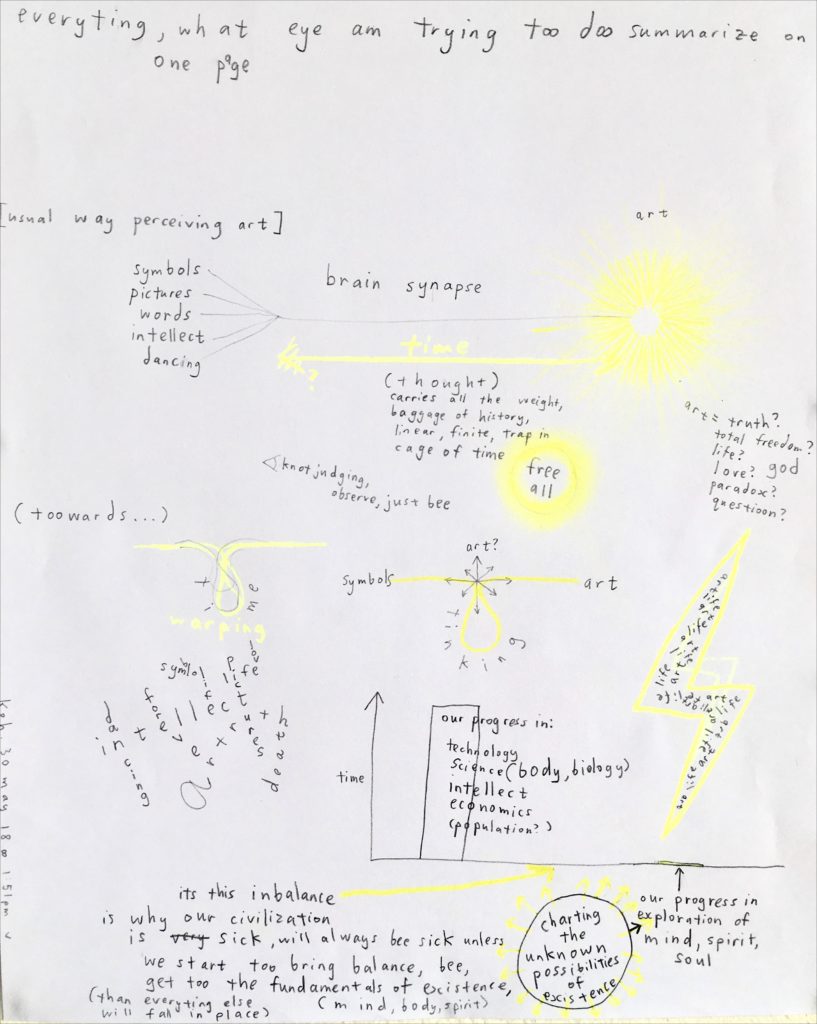
Carla Gannis
To imagine art in 100 years, I've taken a cue from Marge Piercy'southward 1976 speculative fiction novelWoman on the Edge of Time(and aye, possibly I'm hedging my bets besides). Piercy'due south protagonist Connie travels to 2 futurity 2137s, 1 where the environment has stabilized, racial and sexual equality have been achieved, and technology is "organically" interwoven into all life on the planet. The other future is far bleaker. Human dignity, clean air, and autonomous thought are bolt but available to the mega-mega-mega-rich. And so here goes:
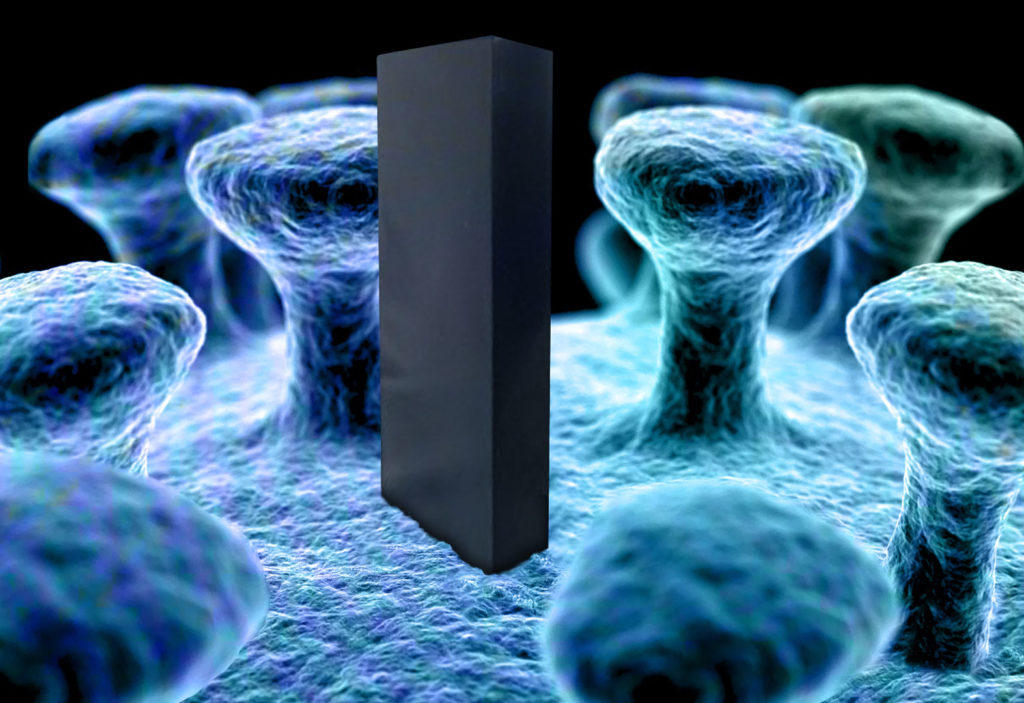
Carla Gannis'due south Abstruse Compressionism (2018). Epitome courtesy of the artist.
Scenario 01
By 2118, the Pentiumcostal Church has a congregation of billions, all worshiping the Chief Algorithm in the Deject, Godgle. The reigning art motion isAbstract Compressionism. The world now has a population of about 20 billion people, and over 250 billion machines (at present called plastes sapiens), and much of the earth'southward surface is no longer inhabitable, thus there is very trivial real manor available for physical works of art. Art is producedand compressed by human "worshipers" using nanotechnology. It is easily viewable to machines & Singularites (cyborgs), but only visible to human being stultus (humans) via exorbitantly expensive virtual simulation implants (besides as church membership fees).
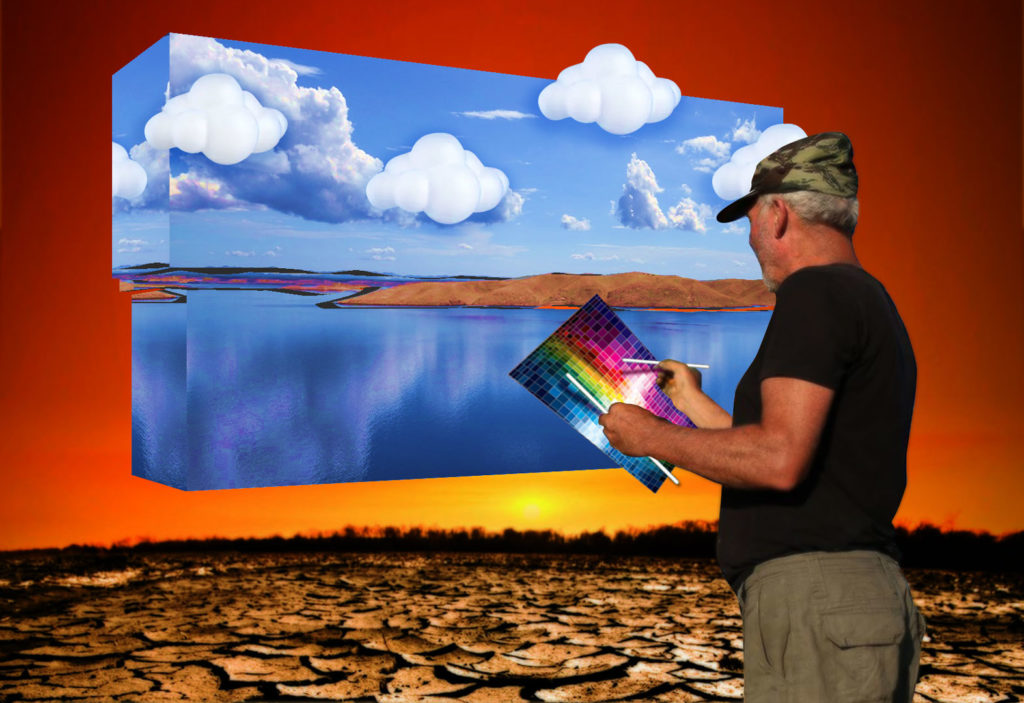
Carla Gannis's Plein Air VRainting (2018). Image courtesy of the artist.
Scenario 02
Humans and machines alive in harmony in the yr 2118. After decades of living secret due to the bio hazardous fall out of the GR8 [e-mail protected] of 2089, the machines have recently stabilized the environment and humans have emerged from their subterranean bunkers, bursting with creative verve.Plein-Air VRainting is all the rage. Every human is an interdataplinary artist now, since machines accept proven to operate the government and economy more efficiently. Most refer to the Earth as the Fine art Earth at present, and robots are keenly invested in universal fine art care for all humans; buying, trading, and selling art via a Dna blockchain organization. Interestingly, a radical grouping of bio-genetically "dehanced" individuals, calling themselvesles Fauves deux points zéro,have begun to garner attention. Painting on cave walls, with berries, roots and leaves, they produce strange images of infinite aliens and unidentified flight objects.
Doug Aitken
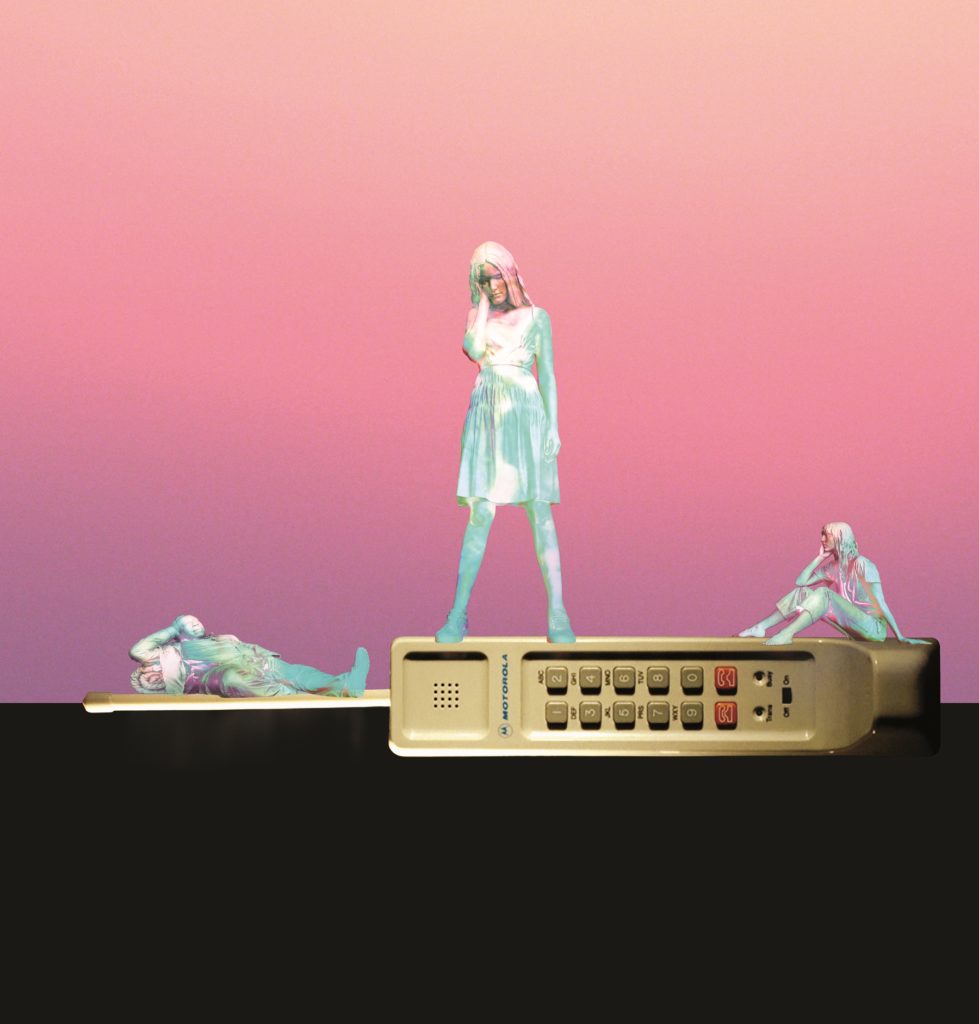
Doug Aitken's 3 Modernistic Figures (don't forget to breathe), (2018). Courtesy of the creative person and Galerie Eva Presenhuber; Paradigm by Doug Aitken Workshop.
I think art is moving in a direction where it will become increasingly de-material. Art in 100 years will be near complete connectivity and dialogue with the viewer with less and less of the detached formalism we come across in art at present. Art will take us to the edge of the horizon and question what is across. Fine art volition seamlessly live both in the fast-flowing river of images and information and in the dull moving desire for true and unrepeatable personal experience.
We are only commencement to understand how engineering is irresolute the human being experience… we are scratching the surface. Creating images is perhaps an existential mode of our gild reminding us we are actually here on earth, and really exist in living flesh and blood. It seems at times similar life is the film… and we are all in information technology together, while at the same fourth dimension each of us is directing our own alive version.
In art, as we move forward, I think the viewer's role volition change and be less passive. There volition be new forms of artworks that are living and continuously irresolute and artworks that volition be more experiential. We will not see fine art every bit something that passively hangs on a wall.
Art volition exist a seamless office of our lives, not a decoration in our lives.
Michelle Grabner
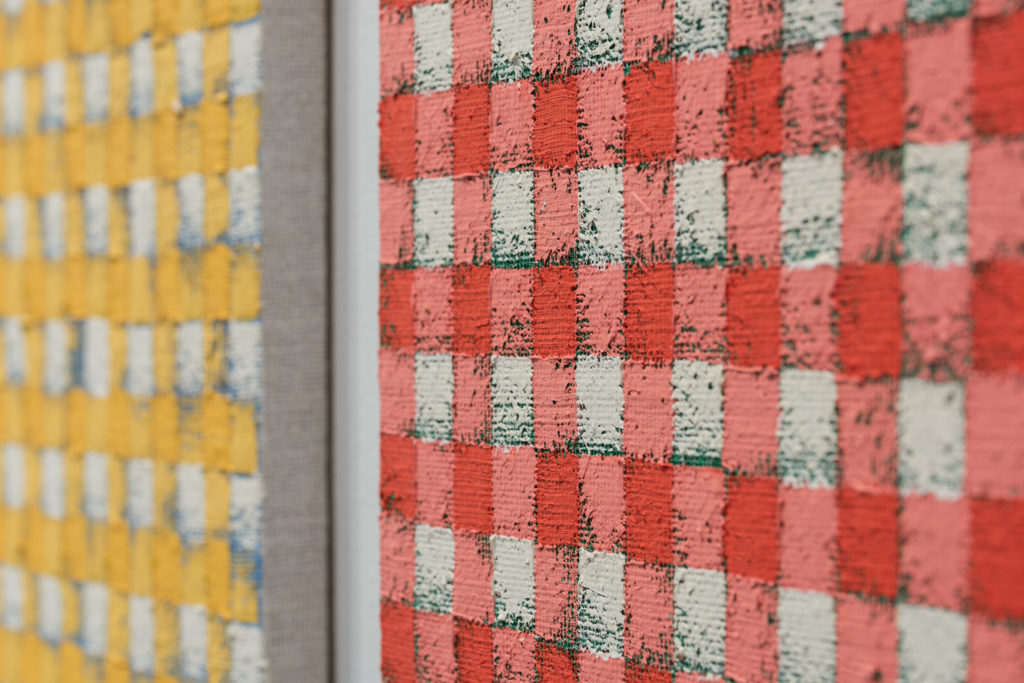
Item of untitled works by Michelle Grabner (2017). Photo past Mario Gallucci, courtesy of Upfor Gallery.
Considering the media revolution of the internet serves economical and not cultural ends, equally the sociologist Jürgen Habermas continues to remind u.s., information technology is likely that the literal object and subject of fine art will be subsumed into an evolving economic system of digital networks. Whatever form art takes, nosotros will not run into it for long, equally our attention will certainly exist evermore commercialized.
Elmgreen & Dragset
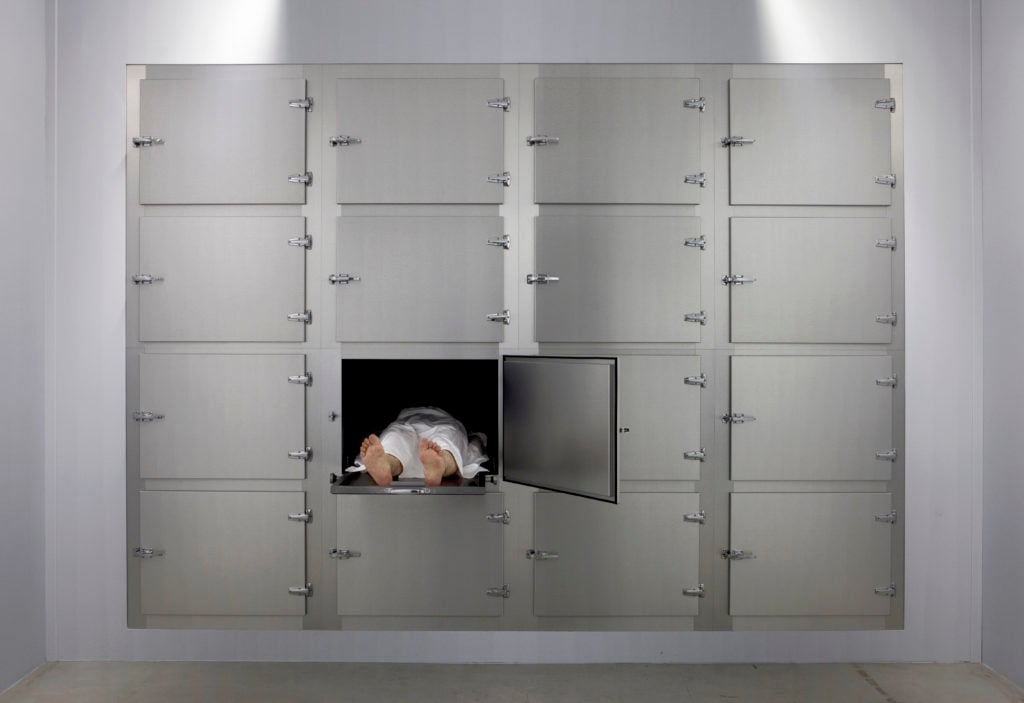
Elmgreen & Dragset, Untitled (2011). Photograph Guillaume Ziccarelli, courtesy Galerie Perrotin.
In 100 years, our electric current global economic organization will about likely have been exchanged with other formats of wealth distribution post-obit the collapse of capitalism, and an art market as we know it today will no longer exist. However, that doesn't hateful that gratis and individual creative expressions will have vanished, but that both artists' practices and art institutions might have undergone radical changes in relation to their cultural functions within society. When it comes to the mediation of art, new generations will certainly have learned to filter the overload of data in more selective ways and will therefore have as well become more immune to media-hyped cultural tendencies and mass hysteria.
Old-school media, such as painting or sculpture, take often been alleged "dead", only to show their renewed strength and relevance less than a decade later. With an increased digitization of our everyday realities, the need for artistic materiality volition get even more urgent in order to remind ourselves that we are concrete beings.
Ebony K. Patterson
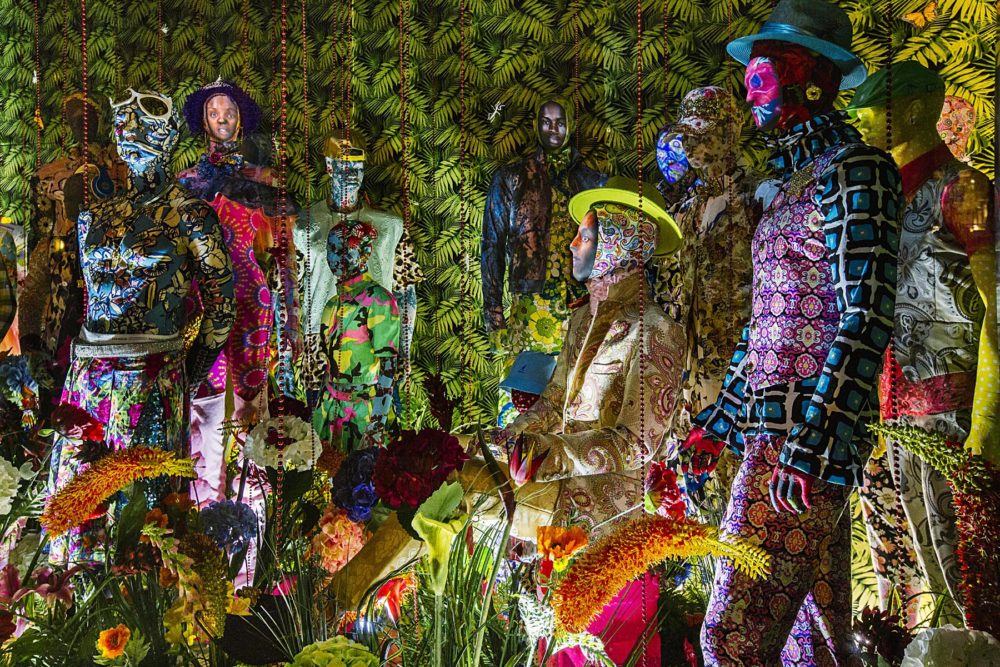
Ebony Grand. Patterson's …PRESENCE… (particular). Image courtesy of the artist and Monique Meloche Gallery.
Hopefully fine art volition reflect more truth. It will be more inclusive and reflect the truth of ALL of US and OUR HISTORIES.
Justin Brice Guariglia

Justin Brice Guariglia'southward JAKOBSHAVN I (2015–2016). ©Justin Brice Guargilia.
Art that rises to the bully ecological challenges of today volition be crucial for our survival equally a species. In a recent event of the journalNATURE, scientists showed that in that location is a 96 percent chance of a whopping 5 degrees Celsius of temperature rising by the year 2100. That kind of rising in the world's temperature is catastrophic for nearly all life on earth, making climate change the moral imperative of our time. Artists have not only the unique ability, only I would argue the responsibility, to give the states new languages and tools to be able to amend empathise the world around us, which can help us solve these great existential problems. This puts tremendous force per unit area on artists to assist society reimagine the future. I believe art as a social do, where artists are invested in the great bug of today, will thrive in the immediate and long term hereafter.
At the same time, AI will leave many people jobless. Forced to accept life in all information technology's meaninglessness, art for fine art sake volition flourish as a style humans will fill the "void of fourth dimension" machines create.
Jacolby Satterwhite
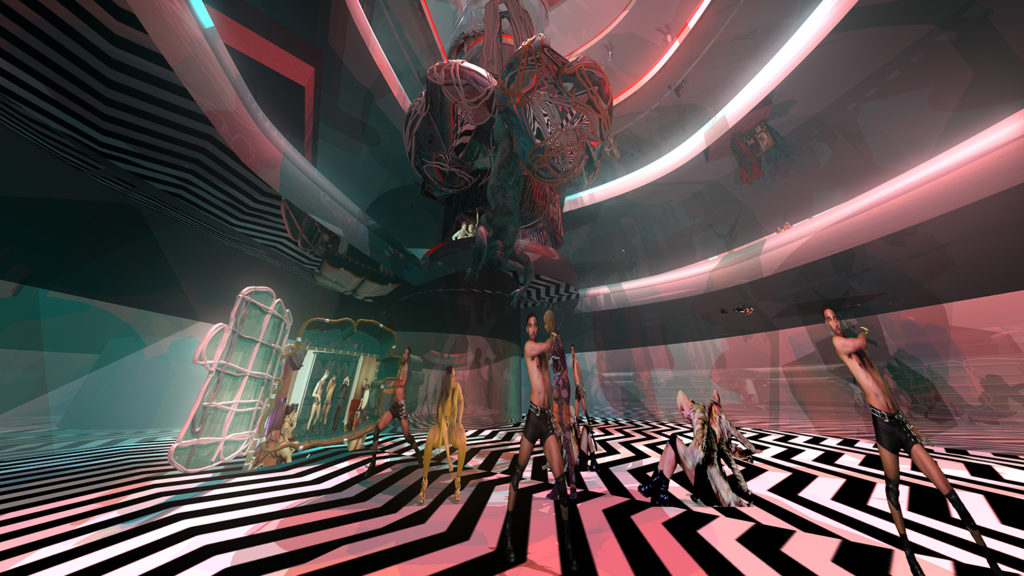
Jacolby Satterwhite, Blessed Artery, nonetheless paradigm. Courtesy of Gavin Brown's Enterprise.
Architecture and Pattern probably volition prevail as a fine art because of the urgency to survive Climate Modify …. that is, if we are still hither.
Luke DuBois

Luke DuBois'southward Learning Machine #iii Audio (2016). © Luke DuBois, courtesy of bitforms gallery.
InVillage on the Holodeck, Janet Murray posits a future where we experience media through social, seamlessly interactive narratives that surround the states and allow the states to straight engage in the performance, image, sound, and touch, as if film, theater, video games, books, and advertising had all merged into something where participants had agency and mere spectatorship would be the exception rather than the dominion. With depression-cost, game-engine driven virtual reality quickly maturing, we can prototype this future with ease, though we still take a long way to go. And so the question is: What about fine art objects that are, by their medium or considering of the creative person's intent, more fixed? Do they too become mutable, or ephemeral, or interactive?
I would flip this question on its head and posit the following: every civilization will use the maximum level of engineering bachelor to it to make works of fine art, and these technologies, tactical obsolescence aside, will be additive to, not replacing of, before technologies. And so solid-state players might crowd out Blu-Ray discs as a superior medium for digital video, but VR will never replace painting.
I call back in 100 years what might change is the means in which (some? many?) artworks are made, a sort of McLuhan/Benjamin apocalypse where everything becomes media, sampled and resampled, and authorship becomes diffuse, computer-assisted, calculator-driven, AI-led—or maybe meticulously "mitt coded", in an inevitable backlash to the machine learning. In the video introduction to Cybernetic Serendipity, Jasia Reichardt really hits the nail on the head past problematizing artist-every bit-sole-author. If this was already dirty territory in 1968 with figurer-driven algorithmic art and simple interactive robotics, past 2118 we might non have individually recognizable artists at all. Everyone will be creatively empowered to express piece of work in any medium… or perhaps the machines volition be on hand to ensure that no one will.
Anicka Yi
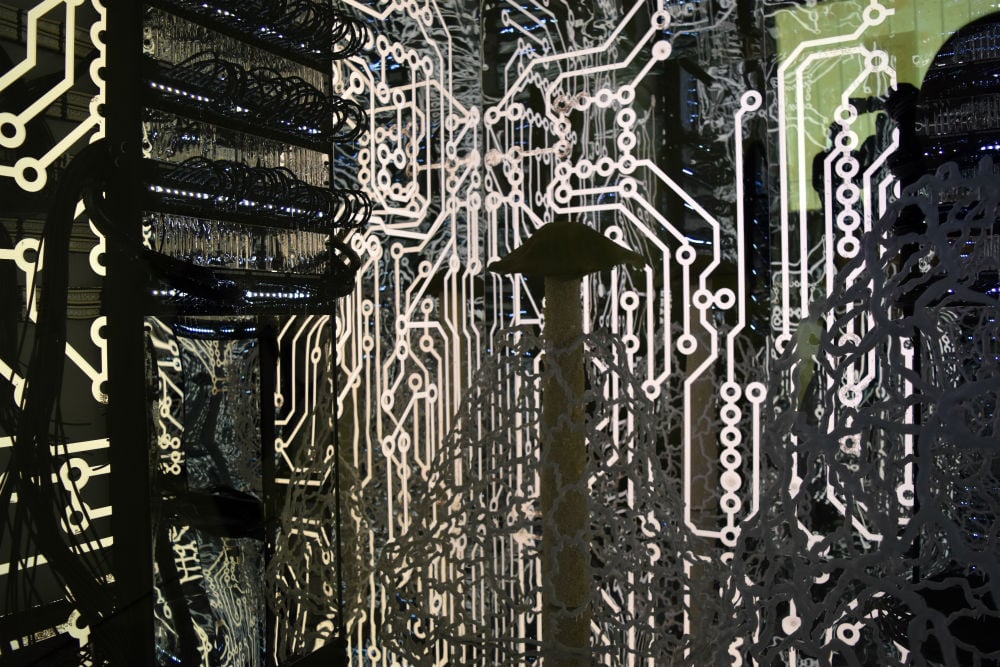
Anicka Yi, Lifestyle Wars at the Guggenheim. Image: Ben Davis.
If the singularity takes over our reality, at that place may non be a need for art. Do machines want or crave fine art? I'grand not sure they would. No thing what, art might be more than algorithmically foregrounded in 100 years.
Nick Cave
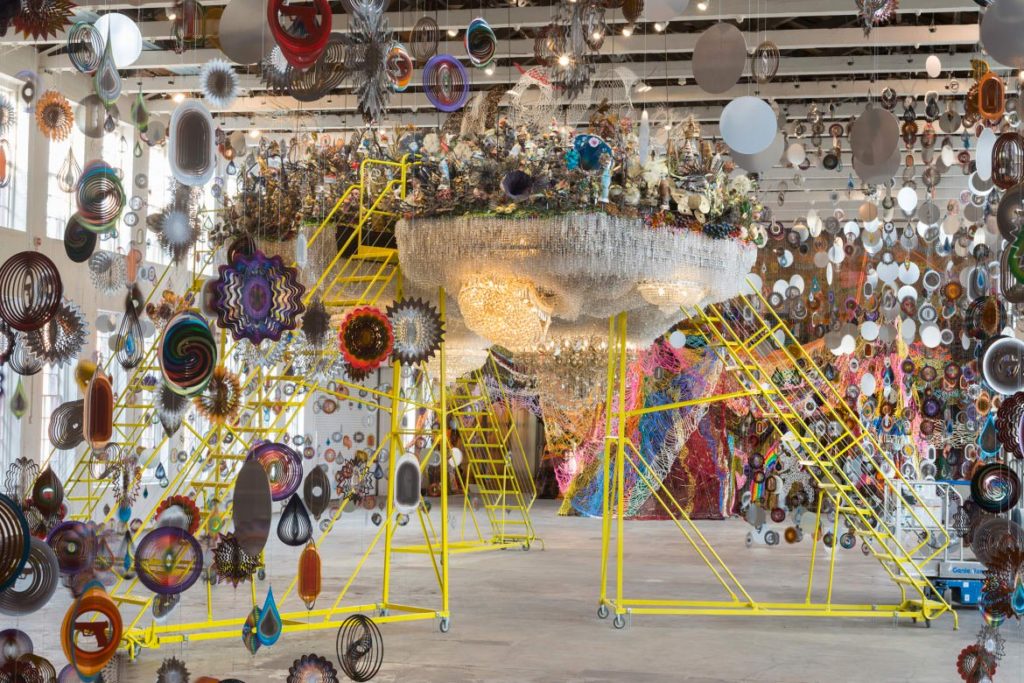
Installation view of Nick Cave'due south Kinetic Spinner Forest and Crystal Cloudscape at "Until", MASS MoCA (2016).
It's all about evolution. Art evolves as nosotros evolve. And it will comprehend all the morphing and new mediums we tin can't quite run into yet.
William Powhida
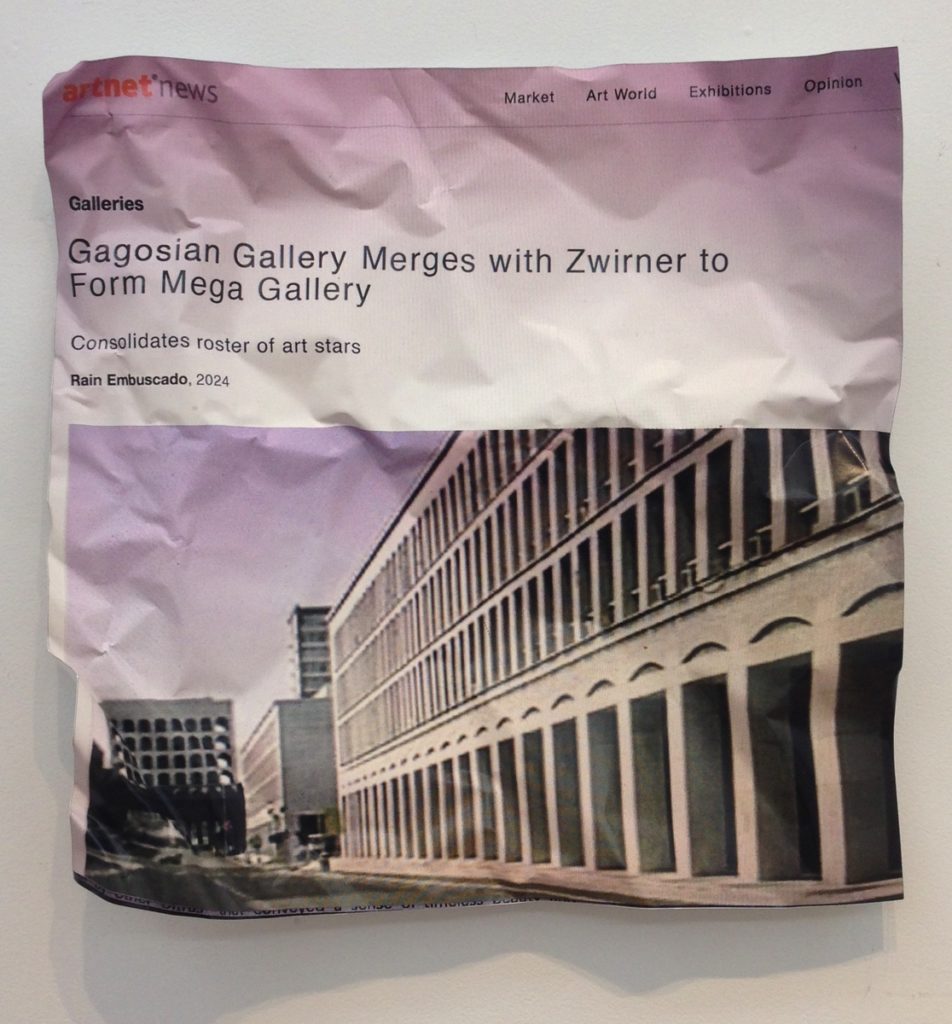
William Powhida's Didactics (Gagosian and Zwirner) (2017). Courtesy of the artist and Postmasters Gallery.
Overall, 2118 will feel more than similar 1918 than our present contemporary moment.
Inside the frame of global capitalism, we are experiencing a reversal of the post-war, democratic redistribution of wealth, putting the earth on a trajectory towards previous social formations—nationalism, aristocracy, feudalism, fascism—that will exist marked by intense grade stratification and international strife as the effects of climate change unfold.
I imagine fine art will also stratify along the aforementioned lines, creating distinct classes of art for the ultra-wealthy, a limited managerial class, a consumer class, and dwindling numbers of a poor underclass (who will exist struggling to survive the withering effects of climatic change).
In 2118, at that place will withal exist name artists who volition serve, and be celebrated by, a tiny audition of ultra-wealthy individuals in the familiar ways. The managerial grade will serve as a "public" audience (significant: crowds) for the inevitable biennials and art fairs that assert the ruling class. Based on the formulas established past these proper noun artists (who volition likely come up from the ultra-class themselves), production houses employing nameless designers and fabricators will serve up variations for the consumer class to feel "art" within an assortment of other pacifying forms of entertainment.
The rest of the world will likely be in survival manner, lacking the minimum corporeality of leisure fourth dimension required for what we understand every bit art, merely should all the same produce some forms of culture that people find entertaining to lookout man today—grim, post-apocalyptic scenarios.
Lia Chavez
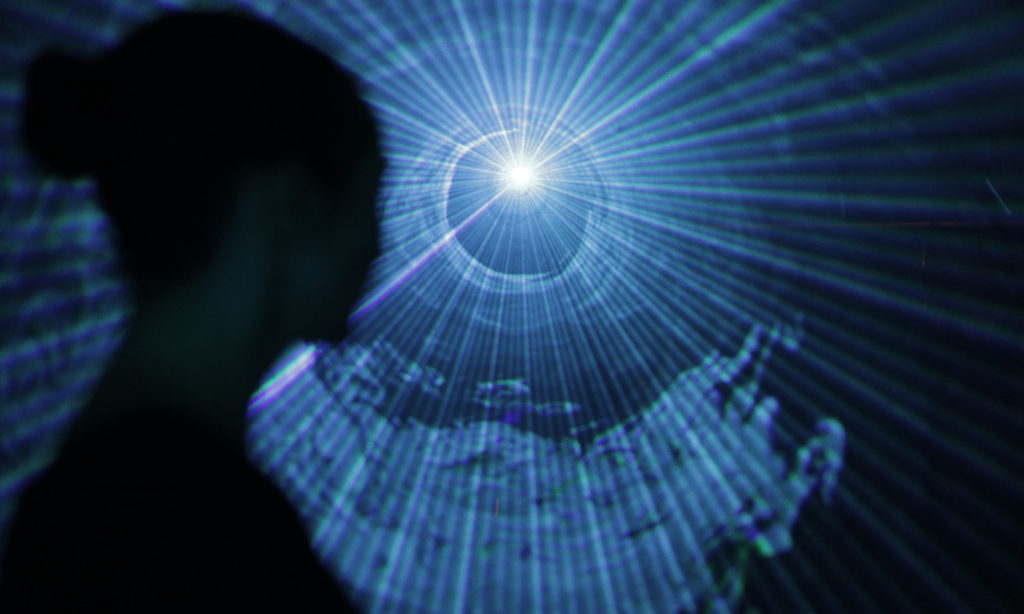
Lia Chavez's "The Octave of Visible Light: A Meditation Nightclub" (2015). © Lia Chavez. Photo: Samuel Cox, courtesy of the artist.
If we still accept food to eat and water to drink, in a hundred years homo creativity will be the single nigh valuable offering in society. AI will be embedded within us, and data will have evolved to become knowledge for rent. The quaternary industrial revolution known as AI will not displace human beings. The techno-materialist paradigm is incapable of grappling with transcendental spiritual experience, then it's inherently limited in the scope of homo feel for which it tin account. The mysterious phenomenon of creative inspiration, with its attendant beauty and otherness, volition go along to confound and delight us, just as it has since aboriginal times.
Max Hooper Schneider

Max Hooper Schneider's The Extinction of Neon four (2018). Courtesy of the creative person and High Art Gallery.
In the next 100 years humans will be dislocated from their assumed position of centrality and superiority every bit knowers and actors in the earth. The hominid fossil tape will be graffitied upon by the extremophile and the insect. Fine art-making and it's ontological linguistic communication, if nonetheless intelligible to our species, will exist opened up to new taxa of intelligence and agential lifeform.
Francesca DiMattio
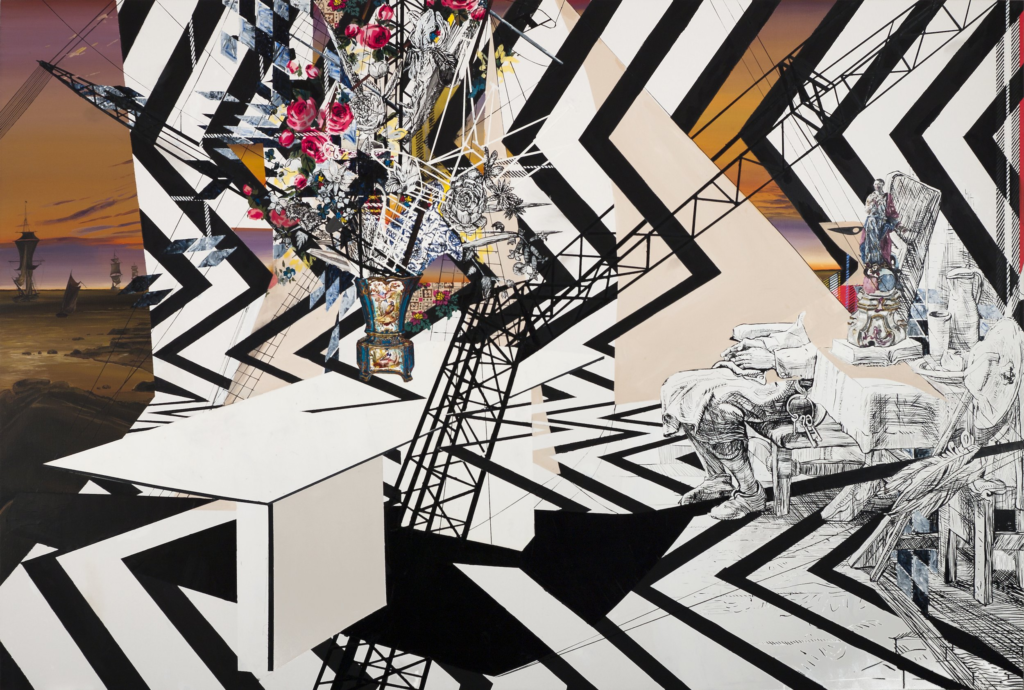
Francesca DiMattio'southward Vestibule (2010). Courtesy of the creative person and Salon 94.
I think art volition have on many different forms as it does today with some new forms we don't know about all the same. I predict that painting will still be. Paintings participate in a historical conversation with works that have come before, and build a parallel abstracted history that I think has great significant because of its constrains and limits. It maps a baroque thread of human contemplation and operates in important contrast to the motivations of politics and engineering science. The Digital will go some other tool like anything else, but as our days and globe become more than and more mediated past technology, the handmade will become fifty-fifty more of import.
Abraham Cruzvillegas
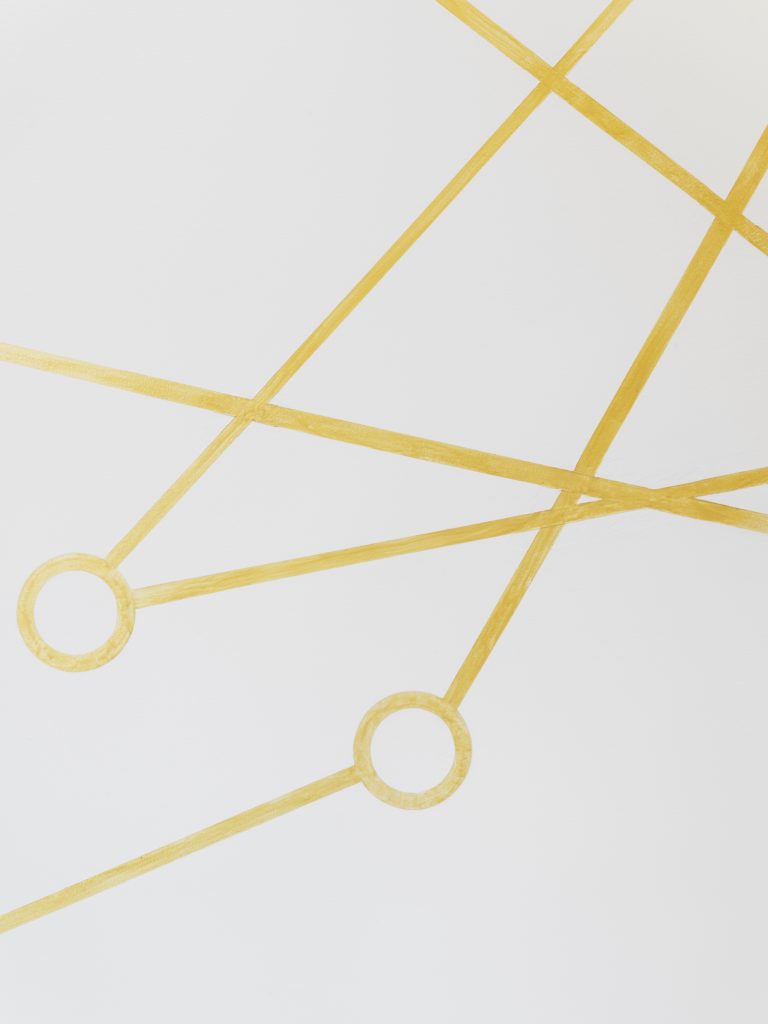
Abraham Cruzvillegas's Downtown selfie [item] (2018). Photo: EPW Stiudio/Maris Hutchinson. Image courtesy of the artist and kurimanzutoo, Mexico Metropolis.
In 100 years, art will be
democratic
affective
emotional
delirious
joyful
affirmative
sweaty
definitely unfinished
fragmentary
communal
empirical
coherent with the mural
laughing
weak
inefficient
unstable
happy
self-constructed
contradictory
handmade
committed
generous
solidary
indecent
sensual
amorphous
renewed
needy
written/told
warm
brief
a craft
engaged
a bullheaded date!
Source: https://news.artnet.com/art-world/art-in-2218-1296347
0 Response to "What Type of Art Will Come in the Future"
Post a Comment